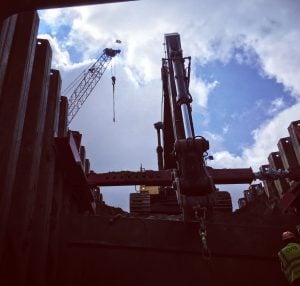Due to the complexity and property line constraints of modern construction, earth shoring requires a solution that must conform to both engineering and safety guidelines during all stages of construction.
Here are the 5 key concepts to remember for an earth shoring design:
1. Applicable codes: The type of project will define the requirements for an engineered earth shoring plan. For instance, a design that allows for inches of deflection at a multi-story urban high-rise may not be compatible with AREMA requirements for railroad earth shoring. While a contractor may be able to get away with using a cantilevered design, a similar design that incorporates the locomotive surcharge loads into the analysis may fail simply by being out of tolerance for railroad deflection guidelines. In this case, the common solution is to add soil anchors to keep the design in compliance.
2. Material: This is typically a contractor preference. If a contractor has a substantial inventory of steel I-beams/H-piles and wood lagging, it is in the best interest of the client for the engineer to design the system accordingly. Piles may need to be spaced more tightly and the design may not be as efficient as sheet piles, but it does eliminate the need for the contractor to spend more money.
3. Sequencing: With most earth shoring designs, there is a sequence of installation that must be followed based on the applied loads that change with depth. For example, in a cofferdam design, if wale frames are required, the contractor may have to install the wale at a specified elevation prior to proceeding. This elevation may be above the final excavation depth, but the engineer should have determined that this is the maximum depth that the shoring can support in a cantilevered condition and/or without restraint at the base. This may be a result of deep excavations where the substrate alone at the base is not adequate to support the lateral load. Oftentimes, many scenarios must be analyzed to ensure that the members are not overloaded and the entire shoring design is code-compliant at any given stage.
4. Embedment Depth: As a general guideline, the minimum embedment depth of a pile must be 75% of the retained height to ensure adequate development and base restraint.
5. Workers at the Top of the Excavation: While the designer may account for the surcharge loads at the top of the excavation, it is also important to consider the impact of workers. If a guardrail is required based on project conditions, then it must be OSHA compliant and any loads/connections required shall be accounted for in the design of the pile. Common practice is to weld a guardrail post at the top of the pile, but this must be checked not only for load application, but also for maximum spacing.
Engineered shoring plans are critical components of construction plans, and a well-thought out design will save the contractor both time and money. As the saying goes,"Think before you dig!"









